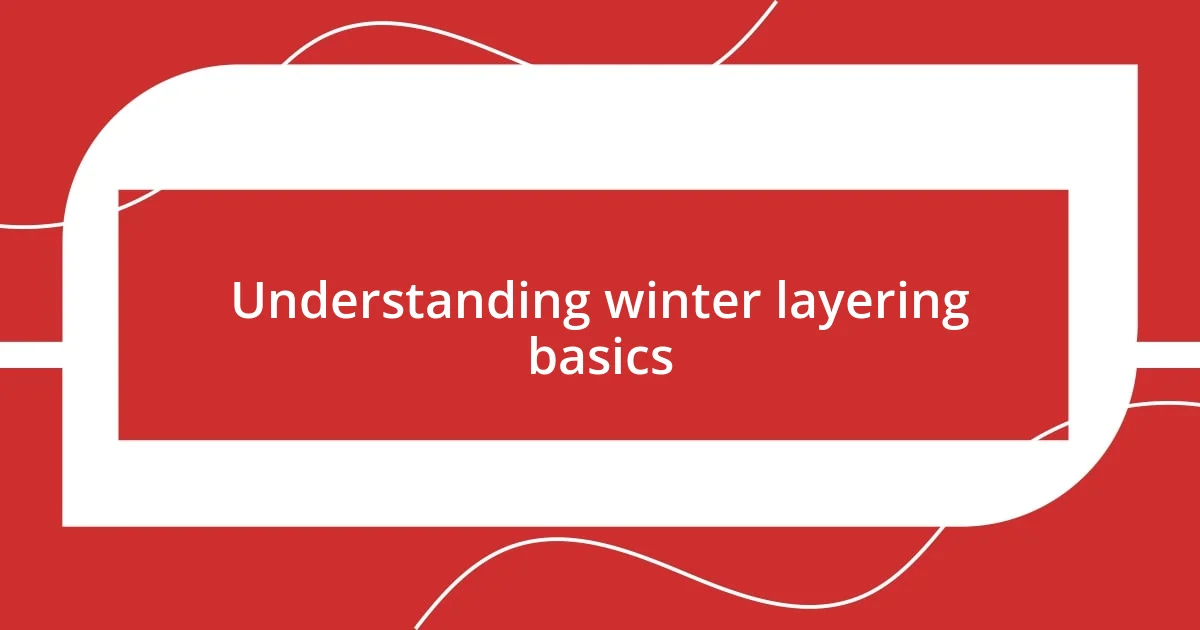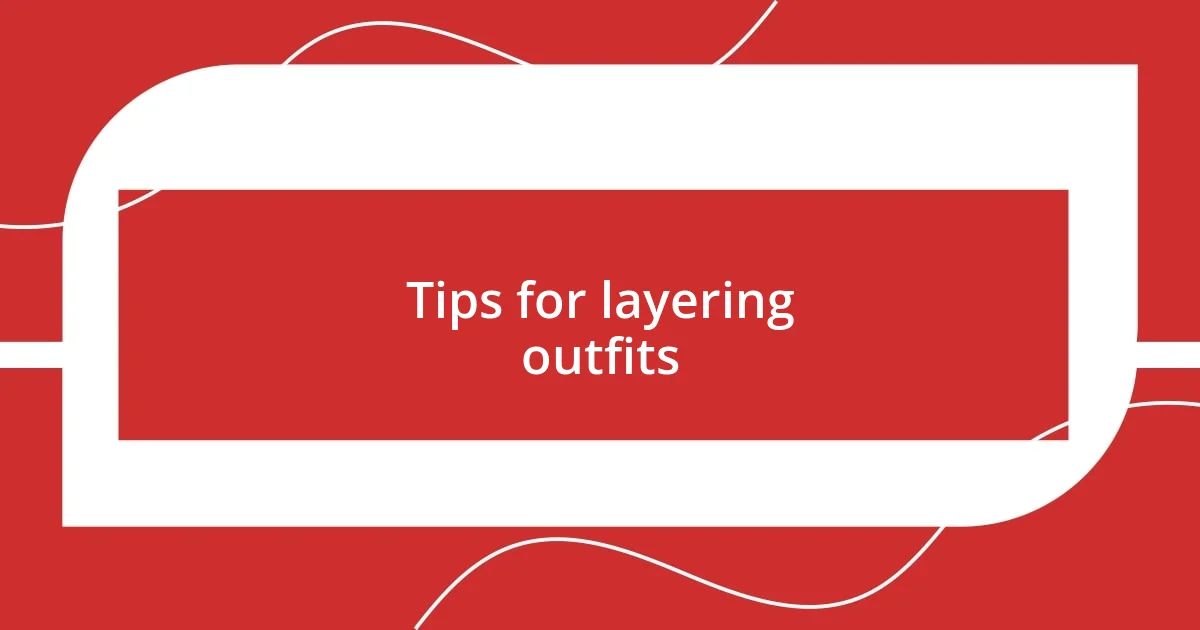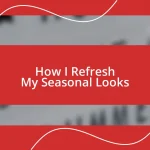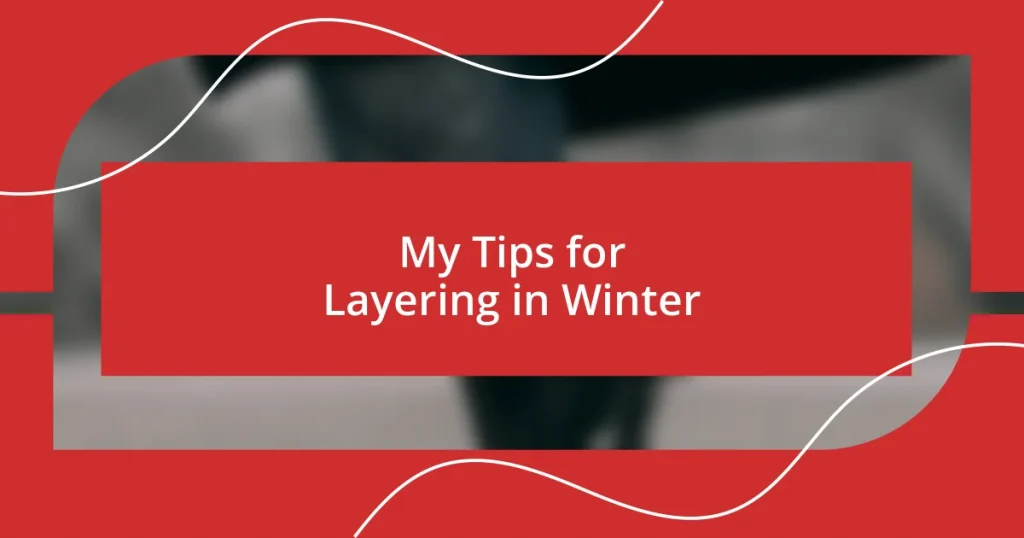Key takeaways:
- Layering should balance warmth and breathability, using moisture-wicking base layers to avoid overheating and chilling.
- Choose insulating middle layers that are lightweight yet warm, and ensure they are breathable to prevent clamminess during activities.
- Select outer layers that are both functional and stylish, made from waterproof materials, allowing for comfortable movement while keeping you protected from the elements.

Understanding winter layering basics
Layering in winter is all about creating a balance between warmth and breathability. I remember the first time I ventured out in the snow, bundled up like the Michelin Man, only to realize I couldn’t move! It’s essential to choose materials that trap heat without making you sweat, as that perspiration can lead to chilling once you step outside.
One mistake I often see is having too many layers, which can actually restrict movement and make you feel heavy. Instead, I find that using a base layer made of moisture-wicking fabric sets the foundation for comfort. Think of it this way: would you prefer a snug hug or a suffocating squeeze from your clothes?
Another crucial point is the middle layer, which provides insulation. I always opt for materials like fleece or down, depending on the temperature. A well-chosen middle layer can act as your cozy shield against the biting cold. Remember, it’s not just about looking good; feeling good in your layers is paramount, especially when you’re out enjoying winter activities!

Choosing the right base layers
When it comes to selecting the right base layers, comfort is non-negotiable. I still recall my first skiing trip; the base layer I chose chafed against my skin all day, and I couldn’t enjoy the slopes. I’ve since learned the importance of selecting fabrics that feel good against the body while keeping moisture at bay.
Here’s what I recommend considering for your base layers:
- Material: Look for moisture-wicking fabrics like merino wool or synthetic blends.
- Fit: A snug yet comfortable fit prevents chafing and ensures warmth.
- Weight: Choose lightweight options for milder days and heavier ones for frigid conditions.
- Seam placement: Flat seams can reduce irritation during movement, which is vital for active winter sports.
Having the right base layer can make or break your winter outings, so invest time in finding something that suits your needs!

Selecting insulating mid layers
When selecting insulating mid layers, I often consider the balance between warmth and weight. During one particularly frigid hike, I wore a heavy sweater that felt like I was toting a sack of potatoes. After that day, I learned to prioritize lightweight options that still retained excellent insulation, such as fleece or well-constructed down jackets. It’s amazing how a good mid layer can wrap you in a warm embrace without overwhelming you.
Another essential factor is breathability. I will never forget a snowshoeing adventure where I chose a less breathable layer. I ended up feeling clammy, and that intense chill hit me like a wave when the sweat cooled. That taught me the hard way that mid layers should allow excessive heat and humidity to escape, thus preventing that uncomfortable feeling of being trapped in your layers. I’ve found that jackets with ventilation zippers are a great solution for those intense winter activities.
Lastly, consider versatility and layering compatibility. I once bought a gorgeous mid layer that unfortunately didn’t fit well under my outer shell. This made it impossible to combine layers effectively. Now, I always ensure my selected mid layers can tuck comfortably under my outer layer without impeding movement. Trust me; slipping on that cozy mid layer after a cold breeze feels like a warm hug on a chilly day!
| Material | Insulation Type |
|---|---|
| Fleece | Lightweight & Breathable |
| Down | High Warmth-to-Weight Ratio |
| Wool | Naturally Insulating & Moisture-Resistant |

Opting for effective outer layers
Choosing the right outer layers is crucial for maintaining warmth and protection against the elements. I remember a particularly biting winter day when I opted for a chic, but too-thin jacket. The regret hit me quickly as the wind bit through the fabric, turning my cozy afternoon walk into an endurance test. Since then, I’ve learned that outer layers should be both stylish and functional, capable of shielding you from wind, rain, and snow without sacrificing comfort.
One important consideration is the fabric used in outer layers. I often choose materials like Gore-Tex or similar waterproof and breathable fabrics, especially on days when the weather is unpredictable. During a hiking trip last winter, a sudden snowstorm made me grateful for my properly selected shell. It kept me dry while allowing my body heat to escape, a balance that made a significant difference in my comfort level. Wouldn’t you want that kind of reliability on a chilly day?
Another factor to keep in mind is the fit and style of your outer layer. I’ve learned the hard way that a too-tight jacket can limit movement, which is no fun when you’re trying to enjoy winter activities. I often look for options that not only fit snugly but also allow enough room for layering beneath. I find that a well-fitted outer layer, with a little extra room for movement, gives me the freedom to fully embrace winter’s adventures. After all, the last thing I want is to feel restricted while having fun in the snow!

Accessorizing for warmth and style
Accessorizing can truly elevate not just your style but also your warmth during those cold winter months. I had an experience where I underestimated the power of a good hat. One frosty afternoon, I ventured out without one, thinking my stylish scarf would do the trick. By the time I’d walked a few blocks, I could feel that biting chill creeping through my ears, making me wish I had chosen a well-insulated beanie instead. Now, I know a cozy, functional hat is non-negotiable – it’s one of those accessories that seamlessly marry function with flair.
Scarves are another critical accessory that can massively influence your winter experience. I remember the first time I wrapped myself in a chunky knit scarf – it felt like a warm hug around my neck. Not only did it shield me from the cold, but it also added a pop of color to my usually muted winter attire. Sometimes, I wonder, why not use this versatile accessory to play with textures and patterns? It really allows for personal expression while keeping the warmth close to your body.
Let’s not forget about gloves and mittens! I learned this the hard way during an outdoor winter festival where I wore thin, fashionable gloves. As the temperatures dipped, I was left shivering, wishing I had opted for a pair of insulated mittens instead. Since then, I always ensure my gloves are not only stylish but also functional. After all, what’s the use of looking good if you’re freezing? I’ve found that the right accessories can turn a chilly day into a cozy adventure, allowing you to enjoy the season fully.

Tips for layering outfits
Layering efficiently is an art that can truly transform your winter experience. For instance, I vividly recall a day when I was all set for a stroll, but I couldn’t quite decide on the right base layer. After throwing on a thin long-sleeve shirt, I quickly realized that it left me feeling chilly, especially as the sun dipped behind the clouds. This taught me that starting with a good thermal base layer can make all the difference in staying warm without bulk. Who doesn’t want that cozy feeling from the get-go?
When it comes to mid-layers, I’ve had my share of trial and error. There was one particular winter trip where I layered a cotton sweatshirt, thinking it would be breathable, but soon discovered it trapped moisture, leaving me feeling damp and cold. Since then, I opt for materials like fleece or merino wool, which not only keep me insulated but also wick away sweat. Have you ever felt that chill creeping in while out enjoying the snow? Choosing the right mid-layer can help you fend off that unwelcome feeling and keep your spirits high.
As for final touches, I recommend experimenting with layering styles. One snowy evening, I was surprised at how a long cardigan over my thermal shirt made me feel trendy while being snug. It’s a reminder that functionality doesn’t have to compromise your style; mixing textures, lengths, and colors can create an exciting look. Ever thought about using layering to express your personality during the winter? It’s definitely a fun way to make your outfit a reflection of who you are while staying warm!

Common layering mistakes to avoid
Many people make the mistake of prioritizing style over warmth when layering. I remember one snowy day when I opted for fashionably tight layers, thinking they’d look sleek. But as I stood there freezing, I realized no outfit is worth sacrificing comfort for. Have you ever chosen style and regretted it moments later? It’s a lesson learned the hard way, and I now always ensure that warmth is my top priority.
Another common error is layering too heavily without considering mobility. I once wore multiple thick layers, feeling invincible until I discovered how cumbersome they were while walking. I could barely lift my arms! It’s easy to forget that you need to move freely to fully enjoy winter activities. Now, I focus on lighter, thermally efficient layers that allow me to enjoy everything from a snowball fight to ice skating—comfortably!
Lastly, neglecting the importance of breathable materials often leads to feeling too hot indoors and freezing outside. I shrugged off my breathable fabric shirt one day in favor of my trusty flannel, thinking it would be warmer. Instead, I ended up sweaty and uncomfortable. It’s taught me to pay attention to how fabrics function, helping me choose wisely. Have you ever been caught in that frustrating cycle of overheating indoors but freezing outside? Learning to tune in to your body’s needs makes a significant difference in overall comfort and enjoyment during winter!












